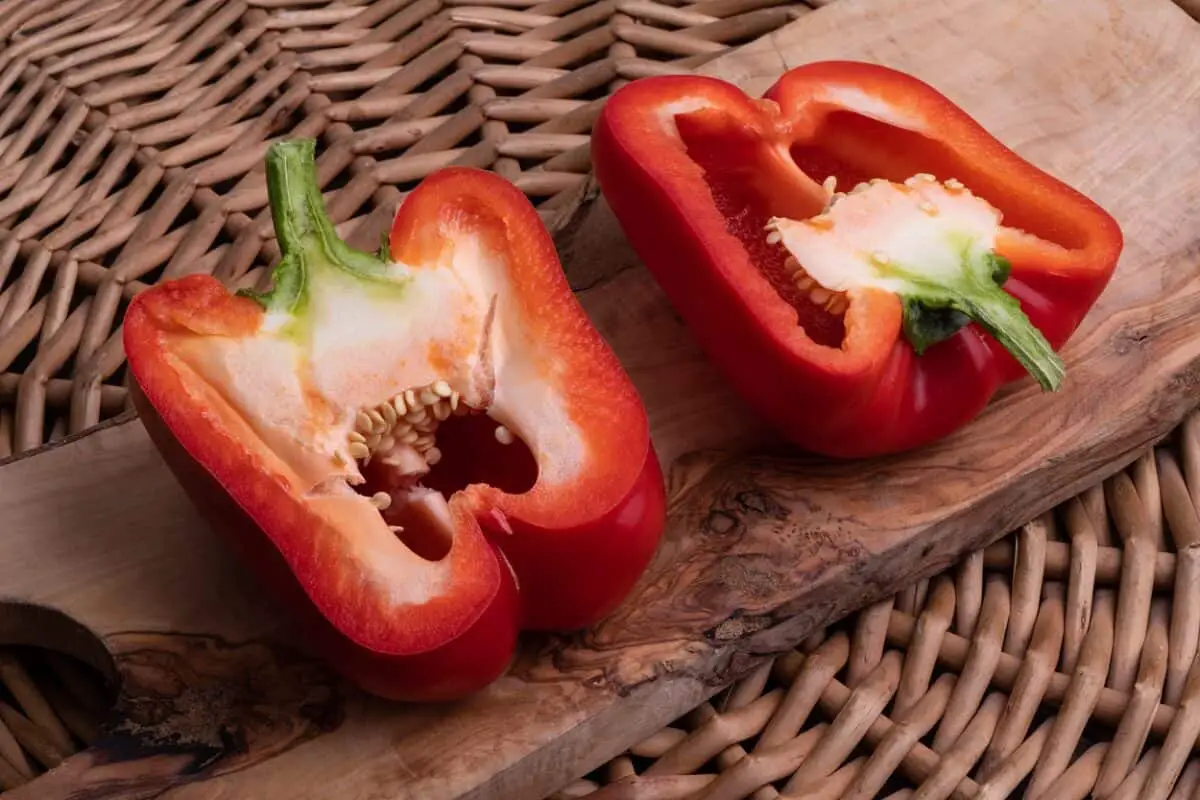Last Updated on 24th July 2023 by
Because there are lots of ways to use bell peppers, I’m going to show you a few different methods for how to cut a bell pepper. You will need to know different techniques depending on how you’re going to use your bell peppers in cooking.
Table of Contents
How to Cut a Bell Pepper
There are few important things you need to know about cutting about pepper no matter how you plan to do it. You always want to deseed it, as the seeds can lend a flavour to the pepper that isn’t very pleasant. You also want to cut the stem off and get rid of the core.
None of these are considered very edible or desirable parts. Most people will never use them in their cooking.
Steps
Step 1: Wash the Pepper
Start by washing the pepper thoroughly under cold running water to remove any dirt, pesticides, or wax that might be on the surface. Dry the pepper with a clean cloth or paper towel.
Step 2: Cut Off the Top and Bottom
Place the pepper on its side on a cutting board. Using a sharp knife, cut off the top and bottom of the pepper. Be careful not to cut too much off, just enough to remove the stem and the small bit at the base.
Step 3: Remove the Core
Stand the pepper upright. With the knife, carefully cut around the inside to remove the white core and seeds. You can also use your hands to pull out the core and any remaining seeds.
Step 4: Cut Vertically
Lay the pepper on its side again and make a vertical cut along one side. This allows you to unroll or open up the pepper.
Step 5: Flatten the Pepper
Now, open up the pepper and lay it flat on the cutting board, skin-side down. You should be able to see all of the inside of the pepper.
Step 6: Remove the White Membranes
Cut out any remaining white parts or membranes with your knife. They can be bitter, so it’s best to remove them.
Step 7: Slice or Dice
For slices, cut the pepper vertically into thin or thick strips, depending on your recipe or preference. For diced pepper, lay the strips side by side and cut them horizontally to create small squares.
You’re making thin slices that are about 1/2 inch to 1/4 of an inch wide. Do this with each of the slices, and you will have strips of bell pepper that you can use for sauté, stir fry, salads, soup, and other dishes.
Step 8: Rinse Again (Optional)
If there are still seeds clinging to the sliced or diced pepper, you can give them a quick rinse under cold water to remove them.
And that’s it! Your bell pepper is now ready to be used in your recipe.
Always remember to be careful when handling sharp knives, and keep your fingers clear of the blade while cutting.
How to Cut a Bell Pepper into Strips
You can get bell pepper strips the way I talked about, but there is another way how to cut a green bell pepper that you may want to try and that may be a little easier for you.
- You can start by cutting off the ends of the pepper- both the top and bottom.
- Then make one slice down the side of the pepper to open it up.
- Take out the core which includes the seeds, and then lay out your pepper flat.
- Remember to face the skin down just like how I said on how to cut a bell pepper above.
Once the pepper is laid out flat, you can slice it easily from one end to the other, simply pushing the pepper toward your knife as you cut.
You’ll be making long strips, and this is the perfect method for how to cut a bell pepper for fajitas. It gives you the longest possible strips, which is perfect for burritos, fajitas, quesadillas, and stir fry.
How to Cut a Bell Pepper for Stuffing
If you’re going to use bell pepper and stuffing, you probably want it diced small. You can simply use the strips you’ve made using the steps above and then cut those strips in the smaller pieces.
A very easy way to do that is to line up your strips and turn them to the side and then make a few cuts across all the strips at once with a long knife.
You’ll have instant diced pepper pieces in a very short time.
This is the quickest method for how to cut up a bell pepper into small pieces for a variety of uses. These small, diced pieces can be used to make salsa, dips, soups, and a variety of other dishes.
Tips for Cutting Bell Peppers
Before cutting bell peppers, be sure your peppers are cleaned properly. Wash them in running water and dry them off before cutting them. This makes them clean so that you don’t get debris and dirt in your food. It is also a good opportunity to check for signs of rotting.
Before cutting the peppers, look for bad spots on the peppers. You can cut these out if you like, but if there is significant rotting or bad spots, then you may want to toss the peppers completely.
Always cut the peppers with the skin side facing down. This makes them much easier to cut, as your knife will slip less. If you try cutting the peppers from the outside, the slippery skin can give you some trouble. The knife will cut through the inside of the pepper a lot easier than it will the outside.
How to Choose the Best Bell Peppers
There are certain things to look forward to bell pepper to determine that it’s good for eating. If you don’t want to waste your money on peppers that have already gone bad and you want your dishes to taste fresh and flavourful and have the right texture, then you need to look for certain attributes in your bell peppers when shopping.
I prefer to buy my bell peppers in the market, as these tend to be fresher, whereas the ones in the grocery have probably been sitting in storage for longer. The market peppers tend to have a longer shelf life.
However, make sure you look for peppers that feel like they have some weight to them.
They should be firm and somewhat heavy. They should also be smooth on the outside. Stay away from peppers that are bumpy, spotty, or discoloured. A few little spots here and there are no big deal, but they should be mostly smooth and clean looking.
Look for peppers that have a very deep and vivid colour. They should be glossy or shiny. If they’re dull looking, they’re probably about to go bad.
It’s best to buy bell peppers when they are in season. When is that? The peak season for bell peppers is from July to September. However, certain regions of the country may have different peak seasons for bell peppers.
How to Store Your Bell Peppers
The best way to store sliced bell peppers or fresh bell peppers that have not been sliced is to put them into a plastic bag in their refrigerator’s crisper drawer. Peppers should be placed in the storage as soon as they are cut and as soon as they come home from the market or grocery.
Be sure to dry them properly before you store them, as water in the plastic bag can constantly degrade faster and become soggy. They can lose their crispiness if there’s any water in the bag.
How long should your peppers last in the fridge after you bring them home? They should last anywhere from four days to about 10 days, depending on how long they were sitting on the shelf before you brought them home.
FAQs
What’s the most efficient way to cut a bell pepper?
The most efficient way to cut a bell pepper is to start by slicing off the top and bottom of the pepper. This allows the pepper to sit flat on your cutting board for stability. Then, cut a vertical slice down one side of the pepper. Lay the pepper down on the cut side, and cut along the inner side of the pepper, unrolling it as you go to remove the seeds and membranes.
Do I need to remove the seeds and ribs from the bell pepper before cutting it?
Yes, you should remove the seeds and the ribs before cutting a bell pepper. The seeds and ribs can have a bitter taste and a tough texture. By removing them, you ensure the pepper pieces are sweet and crunchy.
Is there a difference in the method of cutting a bell pepper for stuffing, slicing, or dicing?
Yes, the method of cutting a bell pepper does depend on the intended use. For stuffing, you would want to cut the bell pepper in half from top to bottom, removing the seeds and ribs. For slicing, you would first remove the top and bottom, and then cut into rings or strips as needed. For dicing, you would cut the pepper into strips before then cutting across to create small cubes.
I'm Pauline, a mother of four grown children, my passion for cooking stemmed from the joy i get cooking for my family. I love to try new dishes, especially when dining out but creating and sharing my own recipes is my favourite thing to do!


